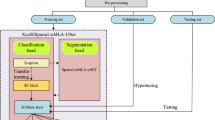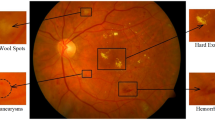Abstract
Diabetic retinopathy (DR) is a kind of eye disorder that injures retinal blood vessels and finally leads to complete visual impairment. The severity of eye conditions can be avoided by taking preventive measures like proper screening, early detection, and timely diagnosis. Nowadays, automated diagnostic systems are developed by researchers to monitor the progression of eye disease. The automated systems use machine learning techniques to discriminate retinal fundus images based on the severity grading. The methodologies currently being used in this domain, however, have several limitations on DR grading tasks, including redundant training time, the use of data annotation, and reduced sensitivity performance. Therefore, we proposed a novel automated diagnostic system using the Komodo Mlipir Algorithm-optimized Attention Bidirectional Long Short-Term Memory (KMA-optimized ABiLSTM) approach to detect the symptoms of DR in the early stage from the retinal fundus images. The retinal fundus images used to evaluate the proposed method were obtained from the MESSIDOR and IDRiD databases. The proposed KMA-optimized ABiLSTM technique detects and categorizes DR abnormalities in datasets as non-DR, mild non-proliferative DR (NPDR), moderate NPDR, severe NPDR, and proliferative DR (PDR). The effectiveness of the proposed KMA-optimized ABiLSTM approach is examined by comparing its performance with other state-of-the-art approaches in terms of diverse performance measures. The experimental analysis inherits that the proposed KMA-optimized ABiLSTM approach achieves a high accuracy rate of about 98.5% with less computation time (50 s) than other state-of-the-art approaches.


Similar content being viewed by others
Availability of data and materials
Data sharing is not applicable to this article as no new data were created or analyzed in this study.
References
Qummar, S., Khan, F.G., Shah, S., Khan, A., Shamshirband, S., Rehman, Z.U., Khan, I.A., Jadoon, W.: A deep learning ensemble approach for diabetic retinopathy detection. IEEE Access 7, 150530–150539 (2019)
Sabanayagam, C., Banu, R., Chee, M.L., Lee, R., Wang, Y.X., Tan, G., Jonas, J.B., Lamoureux, E.L., Cheng, C.Y., Klein, B.E., Mitchell, P.: Incidence and progression of diabetic retinopathy: a systematic review. Lancet Diabetes Endocrinol. 7(2), 140–149 (2019)
Gadekallu, T.R., Khare, N., Bhattacharya, S., Singh, S., Maddikunta, P.K.R., Srivastava, G.: Deep neural networks to predict diabetic retinopathy. J. Ambient Intell. Hum. Comput. 1, 31–14 (2020). https://doi.org/10.1007/s12652-020-01963-7
Ting, D.S.W., Cheung, G.C.M., Wong, T.Y.: Diabetic retinopathy: global prevalence, major risk factors, screening practices and public health challenges: a review. Clin. Exp. Ophthalmol. 44(4), 260–277 (2016)
Ly, A., Phu, J., Katalinic, P., Kalloniatis, M.: An evidence-based approach to the routine use of optical coherence tomography. Clin. Exp. Optom. 102(3), 242–259 (2019)
Richens, J.G., Lee, C.M., Johri, S.: Improving the accuracy of medical diagnosis with causal machine learning. Nat. Commun. 11(1), 1–9 (2020)
Hatua, A., Subudhi, B.N., Veerakumar, T., Ghosh, A.: Early detection of diabetic retinopathy from big data in hadoop framework. Displays 70, 102061 (2021)
Rastrollo-Guerrero, J.L., Gómez-Pulido, J.A., Durán-Domínguez, A.: Analyzing and predicting students’ performance by means of machine learning: a review. Appl. Sci. 10(3), 1042 (2020)
Gadekallu, T.R., Khare, N., Bhattacharya, S., Singh, S., Maddikunta, P.K.R., Ra, I.H., Alazab, M.: Early detection of diabetic retinopathy using PCA-firefly based deep learning model. Electronics 9(2), 274 (2020)
Zhang, G., Sun, B., Chen, Z., Gao, Y., Zhang, Z., Li, K., Yang, W.: Diabetic retinopathy grading by deep graph correlation network on retinal images without manual annotations. Front. Med. (2022). https://doi.org/10.3389/fmed.2022.872214
Mahmoud, M.H., Alamery, S., Fouad, H., Altinawi, A., Youssef, A.E.: An automatic detection system of diabetic retinopathy using a hybrid inductive machine learning algorithm. Personal Ubiquitous Comput. (2021). https://doi.org/10.1007/s00779-020-01519-8
Renith, G., Senthilselvi, A.: Accuracy improvement in diabetic retinopathy detection using DLIA. J. Adv. Res. Dyn. Control Syst. 12(7), 133–149 (2020)
Jiang, Y., Tan, N., Peng, T., Zhang, H.: Retinal vessels segmentation based on dilated multi-scale convolutional neural network. IEEE Access. 7, 76342–76352 (2019)
Jadhav, A.S., Patil, P.B., Biradar, S.: Optimal feature selection-based diabetic retinopathy detection using improved rider optimization algorithm enabled with deep learning. Evol. Intel. 14(4), 1431–1448 (2021)
Sungheetha, A., Sharma, R.: Design an early detection and classification for diabetic retinopathy by deep feature extraction based convolution neural network. J. Trends Comput. Sci. Smart Technol. (TCSST) 3(02), 81–94 (2021)
Fang, L., Qiao, H.: Diabetic retinopathy classification using a novel DAG network based on multi-feature of fundus images. Biomed. Signal Process. Control 77, 103810 (2022)
Park, J., Hwang, E.: A two-stage multistep-ahead electricity load forecasting scheme based on LightGBM and attention-BiLSTM. Sensors 21(22), 7697 (2021)
Suyanto, S., Ariyanto, A.A., Ariyanto, A.F.: Komodo Mlipir algorithm. Appl. Soft Comput. 114, 108043 (2022)
Giancardo, L., Meriaudeau, F., Karnowski, T.P., Li, Y., Garg, S., Tobin, K.W., Jr., Chaum, E.: Exudate-based diabetic macular edema detection in fundus images using publicly available datasets. Med. Image Anal. 16(1), 216–226 (2012)
Abràmoff, M.D., Lou, Y., Erginay, A., Clarida, W., Amelon, R., Folk, J.C., Niemeijer, M.: Improved automated detection of diabetic retinopathy on a publicly available dataset through integration of deep learning. Invest. Ophthalmol. Vis. Sci. 57(13), 5200–5206 (2016)
Porwal, P., Pachade, S., Kamble, R., Kokare, M., Deshmukh, G., Sahasrabuddhe, V., Meriaudeau, F.: Indian diabetic retinopathy image dataset (IDRiD): a database for diabetic retinopathy screening research. Data 3(3), 25 (2018)
Badgujar, R.D., Deore, P.J.: Hybrid nature inspired SMO-GBM classifier for exudate classification on fundus retinal images. IRBM 40(2), 69–77 (2019)
Deepak, K.S., Sivaswamy, J.: Automatic assessment of macular edema from color retinal images. IEEE Trans. Med. Imaging 31(3), 766–776 (2011)
Irfan, M., Jiangbin, Z., Iqbal, M., Masood, Z., Arif, M.H.: Knowledge extraction and retention based continual learning by using convolutional autoencoder-based learning classifier system. Inf. Sci. 591, 287–305 (2022)
Irfan, M., Jiangbin, Z., Iqbal, M., Arif, M.H.: Enhancing learning classifier systems through convolutional autoencoder to classify underwater images. Soft. Comput. 25(15), 10423–10440 (2021)
Abirami, A., Kavitha, R.: An efficient early detection of diabetic retinopathy using dwarf mongoose optimization based deep belief network. Concurrency Comput. Pract. Experience, 34(28), e7364 (2022)
Gundluru, N., Rajput, D.S., Lakshmanna, K., Kaluri, R., Shorfuzzaman, M., Uddin, M., Rahman Khan, M.A.: Enhancement of detection of diabetic retinopathy using Harris Hawks optimization with deep learning model. Comput. Intell. Neurosci. (2022). https://doi.org/10.1155/2022/8512469
Funding
Not applicable.
Author information
Authors and Affiliations
Contributions
All authors who participated in data analysis, drafting or revising the manuscript gave approval of the final version to be published.
Corresponding author
Ethics declarations
Conflict of interest
The authors declare that they have no conflict of interest.
Human and animal rights
This article does not contain any studies with human or animal subjects performed by any of the authors.
Informed consent
Informed consent was obtained from all individual participants included in the study.
Additional information
Publisher's Note
Springer Nature remains neutral with regard to jurisdictional claims in published maps and institutional affiliations.
Supplementary Information
Below is the link to the electronic supplementary material.
Rights and permissions
Springer Nature or its licensor (e.g. a society or other partner) holds exclusive rights to this article under a publishing agreement with the author(s) or other rightsholder(s); author self-archiving of the accepted manuscript version of this article is solely governed by the terms of such publishing agreement and applicable law.
About this article
Cite this article
Abirami, A., Kavitha, R. A novel automated komodo Mlipir optimization-based attention BiLSTM for early detection of diabetic retinopathy. SIViP 17, 1945–1953 (2023). https://doi.org/10.1007/s11760-022-02407-9
Received:
Revised:
Accepted:
Published:
Issue Date:
DOI: https://doi.org/10.1007/s11760-022-02407-9




